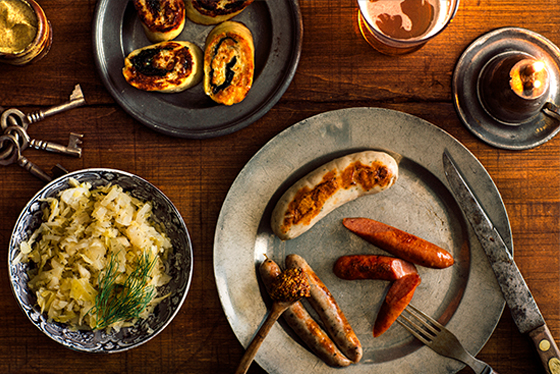
When Schroeder’s revealed the building’s origins as a beer saloon dating back to 1857, restoring it as a brewery became his goal.
When Tom Schroeder decided to buy and restore a historic limestone building at 445 Smith Ave., St. Paul, Minn., he had no idea of the journey that lay ahead to become a brewery and restaurant operator.
Actual history is woven into daily operations of Waldmann Brewery, opened in 2017 in St. Paul’s oldest surviving commercial building, a former German lager saloon. “People get to time-travel while enjoying our beer and food from a modern—albeit tiny—kitchen,” Schroeder says.
“Waldmann Brewery sports the largest collection of mid-19th century saloon chairs that you’ll find anywhere, whale-oil lamps (burning paraffin) on tables, and period hand-blown glass,” Schroeder says. On the walls hang framed antique maps and engravings, along with portraits of original owner Anton Waldmann and the saloon’s master stonemason Jacob Amos. Wood-burning cast-iron stoves complement the building’s HVAC system to warm dining rooms during winter.
“The building itself features hand-planed woodwork and many of the structure’s original square-cut nails. Customers may not notice these details, but the combined feel is palpable,” Schroeder says.
As originally printed in FER Magazine fermag.com
In The Beginning
The project began in ’08 as a way to save the pre-Civil War-era limestone structure from demolition. “It had been used as a residence for 154 years, but in its first life had clearly been something other than a house,” says Schroeder, a dedicated supporter of historic preservation in the St. Paul area. When Schroeder’s research revealed the building’s origins as a lager beer saloon dating back to 1857, restoring it as a brewery became his goal.

chroeder enlisted St. Paul-based architect John Yust, AIA, a specialist in historic restorations, along with a team of volunteer and professional historians, archeologists, craftsmen-carpenters and other contractors. Restoration work on the 1,020-sq.-ft. building began in 2012. But getting permission from the city became a project unto itself. “The lot had been zoned as a residential site for decades,” recalls Schroeder. “We worked with the city to address the zoning problem by proposing an ordinance that would allow historic structures to be used for their original purposes. It took about four years for the ordinance to be enacted.”
St. Paul officially designated the structure a Heritage Preservation Site in ’15. After 11 hearings before the zoning board and two public hearings before the City Council, it granted the building a Historic Use Variance permit in ’16, opening the way for a brewery to set up operations in a neighborhood.

Equipping Waldmann’s Kitchen
For the foodservice side of the project, Schroeder tapped Connie Dickson, FCSI, Principal, Rippe Associates, Minneapolis, to design the kitchen layout. Karl Gerstenberger, a chef and butcher with a background in traditional sausage making, joined the team shortly after the first round of architectural drawings was completed.
“The limited kitchen space was challenging,” Dickson says. “I fell in love with the goals for this project and with Tom, John, Drew [Ruggles, a brewer], and Karl’s passion for history, food and beer. This team proved resourceful and flexible in determining how to get the most from a tight footprint.”
Gerstenberger developed a menu for Waldmann Brewery inspired by an ’05 visit to a historic restaurant in Regensburg, Germany. “I put together a set of images and food concepts based on smoked sausage, cheese and beer that clicked with everyone. Then it was a matter of working with Connie to design a kitchen with adequate work surfaces for food prep, and enough hot power to execute,” Gerstenberger says.
“We ended up with a production-oriented space that could manufacture a fine-textured German-style bratwurst,” says Gerstenberger, whose background with the USDA makes him a self-proclaimed “meat nerd.” The team replaced the smoker with a pair of stacked, half-size convection ovens. They added a buffalo chopper, used for sausage production, in the back corner, along with two high-output burners.
History, Flavor

Waldmann’s may have been billed as a brewery, but before long, the restaurant side of operations became as important as the lager side.
“When you design a space, you have a preconceived notion of how it will operate. Then it opens and people start coming in. That’s when you discover what it really is,” Gerstenberger says.
“Most breweries tend to take an industrial space, make it feel modern and cool, with seating around the beer tanks. With Waldmann, though, we’ve got charm and history. We worked hard to capture the traditional side of a brewery, but once we opened, people perceived us to be a restaurant first.” Indeed, some months, the restaurant side of the business accounts for up to 60% of sales, Schroeder reports.
Waldmann’s house-made sausages dominated the production schedule from the beginning. “Early on, we started with a one-day-a-week sausage making. This soon changed to two days a week—Sunday mornings and all Monday— where we would crank out up to 150 lb. of linked sausages,” Gerstenberger says.
These days, the Waldmann team is working to maintain the saloon’s balance as both a restaurant and a brewery. Customers are drawn to the experience of drinking and dining in a living museum.
“It’s not a competition between the two,” Schroeder emphasizes. “Both beer and food were important parts of German lager beer saloons historically. And both are still important today in terms of differentiating ourselves in the market.”
Discover how Specifi’s Design software to provide architects and commercial kitchen designers all of the tools necessary to build all sorts of commercial kitchens.
Watch this 3 minute video to see how we can help you save time and assure the accuracy of your commercial kitchen projects
The post Historic Minnesota Brewery Gets a Modern Reboot appeared first on Specifi®.

